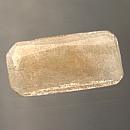|
Click on a letter above to view the list of gems. |
|
|
|
|
|
|
|
|
Searlesite |
|
| | |
| Discovered in 1914; IMA status: Valid (pre-IMA; Grandfathered) | ||
|
| ||
|
Chemistry |
|
|
| |
|
NaBSi2O5(OH)2 | |
|
|
Sodium Boron Silicate Hydroxide |
|
Molecular Weight: |
203.98 gm |
|
Composition: |
Sodium |
11.27 % |
Na |
15.19 % |
Na2O |
|
|
Silicon |
27.54 % |
Si |
58.91 % |
SiO2 |
|
|
Boron |
5.30 % |
B |
17.06 % |
B2O3 |
|
|
Hydrogen |
0.99 % |
H |
8.83 % |
H2O |
|
|
Oxygen |
54.90 % |
O |
|
|
|
|
|
100.00 % |
|
100.00 % |
= TOTAL OXIDE |
|
|
|
||||
|
Classification |
|
|
| |
|
Silicates (Germanates) | |
|
8/G.05-10 | |
|
|
9 : SILICATES (Germanates) |
|
|
|
|
Crystal Data |
|
|
|
|
|
Flat crystals, to 17 cm, occur along bedding planes. Commonly as spherulitic aggregates of radiating acicular to prismatic crystals; as massive granular aggregates. |
|
|
None |
|
|
|
|
|
Physical Properties |
|
|
|
|
|
Perfect on {100}; imperfect on {102}, {010} |
|
|
Fibrous |
|
|
Brittle, Fibrous |
|
|
1.0 - 2.0 |
|
|
2.44 - 2.46 (g/cm3) |
|
|
Fluorescent; SW UV = blue green or green, LW UV = orange |
|
|
Not Radioactive |
|
|
Other: | |
|
|
|
|
Optical Properties |
|
|
|
|
|
Colorless, White, light Brown |
|
|
Translucent to Transparent |
|
|
Vitreous, slightly pearly on cleavage surfaces |
|
|
1.515 - 1.535 Biaxial ( - ) |
|
|
0.0110 - 0.0200 |
|
|
None |
|
|
None |
|
|
|
|
|
Occurances |
|
|
|
|
|
Geological Setting: |
Commonly interbedded with oil shales or marls (Green River Formation, USA); in boron-bearing evaporite deposits (California, USA); rarely in vugs in phonolite (Point of Rocks, New Mexico, USA). |
|
Common Associations: |
Shortite, Trona, Pyrite (Green River Formation, USA); "Opal" (Cave Springs Wash, Nevada, USA) |
|
Common Impurities: |
Al,Fe,Mg,H2O |
|
Type Locality: |
Searles Lake, San Bernardino County, California, USA |
|
Year Discovered: |
1914 |
|
View mineral photos: | |
|
|
|
|
More Information |
|
|
|
|
|
| |
|
|
|
|
Searlesite
can be found in the USA, at Searles Lake, San Bernardino
County, in the Kramer borate deposit, Kern County, and
at Lake Tecopa, Inyo County, California; widespread
in the Green River Formation of Utah and Wyoming; from
Cave Springs Wash, Silver Peak Range, Esmeralda County,
Nevada; and at Point of Rocks, Colfax County, New Mexico.
In Canada, at Mont Saint-Hilaire, Quebec. From Kremna,
near Tito Uzice; Lopare; and near Bela Stena, Yugoslavia.
|
|
|
We
have not photographed our Searlesite gems. Please
check back soon. |
